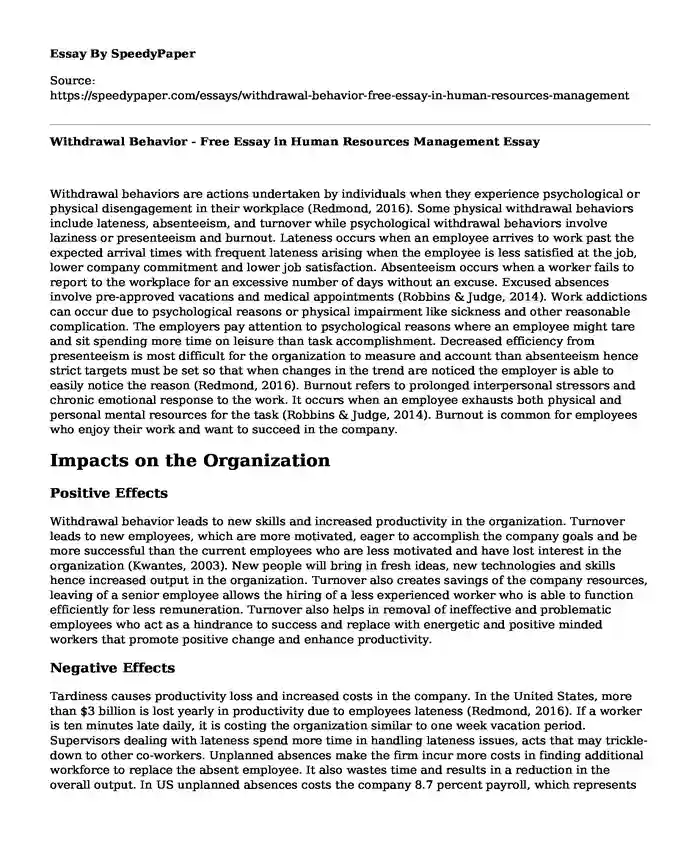
| Type of paper: | Essay |
| Categories: | Management Human resources Organizational behavior |
| Pages: | 3 |
| Wordcount: | 616 words |
Withdrawal behaviors are actions undertaken by individuals when they experience psychological or physical disengagement in their workplace (Redmond, 2016). Some physical withdrawal behaviors include lateness, absenteeism, and turnover while psychological withdrawal behaviors involve laziness or presenteeism and burnout. Lateness occurs when an employee arrives to work past the expected arrival times with frequent lateness arising when the employee is less satisfied at the job, lower company commitment and lower job satisfaction. Absenteeism occurs when a worker fails to report to the workplace for an excessive number of days without an excuse. Excused absences involve pre-approved vacations and medical appointments (Robbins & Judge, 2014). Work addictions can occur due to psychological reasons or physical impairment like sickness and other reasonable complication. The employers pay attention to psychological reasons where an employee might tare and sit spending more time on leisure than task accomplishment. Decreased efficiency from presenteeism is most difficult for the organization to measure and account than absenteeism hence strict targets must be set so that when changes in the trend are noticed the employer is able to easily notice the reason (Redmond, 2016). Burnout refers to prolonged interpersonal stressors and chronic emotional response to the work. It occurs when an employee exhausts both physical and personal mental resources for the task (Robbins & Judge, 2014). Burnout is common for employees who enjoy their work and want to succeed in the company.
Impacts on the Organization
Positive Effects
Withdrawal behavior leads to new skills and increased productivity in the organization. Turnover leads to new employees, which are more motivated, eager to accomplish the company goals and be more successful than the current employees who are less motivated and have lost interest in the organization (Kwantes, 2003). New people will bring in fresh ideas, new technologies and skills hence increased output in the organization. Turnover also creates savings of the company resources, leaving of a senior employee allows the hiring of a less experienced worker who is able to function efficiently for less remuneration. Turnover also helps in removal of ineffective and problematic employees who act as a hindrance to success and replace with energetic and positive minded workers that promote positive change and enhance productivity.
Negative Effects
Tardiness causes productivity loss and increased costs in the company. In the United States, more than $3 billion is lost yearly in productivity due to employees lateness (Redmond, 2016). If a worker is ten minutes late daily, it is costing the organization similar to one week vacation period. Supervisors dealing with lateness spend more time in handling lateness issues, acts that may trickle-down to other co-workers. Unplanned absences make the firm incur more costs in finding additional workforce to replace the absent employee. It also wastes time and results in a reduction in the overall output. In US unplanned absences costs the company 8.7 percent payroll, which represents more than half of healthcare costs (Robbins & Judge, 2014). Withdrawal behavior results in employee demoralization and poor management. When an organization loses highly skilled personnel, the motivation of other workers suffers and can result in the hiring of new workers, which may end up in poor management affecting the overall productivity. Replacement is competitive and expensive to find a qualified applicant. Employee burnout decreases employee commitment and motivation leading to declining in output and revenues (Kwantes, 2003). Employers must set policies and regulations in dealing with withdrawal behaviors to ensure increased productivity and organizations success.
References
Kwantes, C. T. (2003). Organizational Citizenship and Withdrawal Behaviors in the USA and India. International Journal of Cross Cultural Management, 34-40.
Robbins, S., & Judge, T. A. (2014). Organizational Behavior Student Value Edition. Peru: Pearson College.
Withdrawal Behaviors. (2016, November 20). Retrieved May 26, 2018, from Work Attitudes and Job Motivation: https://wikispaces.psu.edu/display/PSYCH484/13.+Withdrawal+Behaviors
Cite this page
Withdrawal Behavior - Free Essay in Human Resources Management. (2022, Jun 08). Retrieved from https://speedypaper.com/essays/withdrawal-behavior-free-essay-in-human-resources-management
Request Removal
If you are the original author of this essay and no longer wish to have it published on the SpeedyPaper website, please click below to request its removal:
- Free Essay on the Educational Approach to Research
- What Is the Spa Industry? Free Essay Sample
- The Social Construction of Gender, Free Essay in Sociology
- Essay Analysis: 'No Need to Call', Free Example
- Essay Sample on Ted Talk Analysis
- Free Essay Example on Skin Rosacea
- Essay Sample: Time Travelling For Health Specialist
Popular categories




